Preparation and Application of Apatite–TiO2 Composite Opacifier: Preventing Titanium Glaze Yellowing through Pre-Combination
Abstract
1. Introduction
2. Materials and Methods
2.1. Materials
2.2. Preparation of ATO and Sanitary Ceramic Glaze
2.3. Characterization
3. Results
3.1. Morphology and Structure of ATO
3.1.1. Effect of the TiO2 Ratio on the Morphology of ATO
3.1.2. Phase Analysis of ATO
3.1.3. Binding Properties between Apatite and TiO2
3.2. The Glaze Performance of Sanitary Ceramics with an ATO
3.2.1. Effect of TiO2 Content in ATO on the Glaze Properties of Sanitary Ceramics
3.2.2. Comparison of Properties between Ceramic Glazes with ATO, PTO, ZrSiO4, and TiO2 as Opacifiers
3.3. Mechanism of ATO
3.3.1. Phase Analysis
3.3.2. Morphology Analysis
4. Conclusions
Author Contributions
Funding
Data Availability Statement
Conflicts of Interest
References
- Casasola, R.; Rincón, J.M.; Romero, M. Glass-ceramic glazes for ceramic tiles: A review. J. Mater. Sci. 2012, 47, 553–582. [Google Scholar] [CrossRef]
- Tang, H.D.; Hu, Q.; Jiang, F.; Jiang, W.H.; Liu, J.M.; Chen, T.; Feng, G.; Wang, T.; Luo, W. Size control of C@ZrSiO4 pigments via soft mechano-chemistry assisted non-aqueous sol-gel method and their application in ceramic glaze. Ceram. Int. 2019, 45, 10756–10764. [Google Scholar] [CrossRef]
- Molera, J.; Pradell, T.; Salvadó, N.; Vendrell-Saz, M. Evidence of tin oxide recrystallization in opacified lead glazes. J. Am. Ceram. Soc. 1999, 82, 2871–2875. [Google Scholar] [CrossRef]
- Noble, B.D.; Parker, J.M.; James, P.F.; Hand, R.J.; Smith, A.; Booth, J. Opacification of ZnO-B2O3-ZrO2 glasses. Glass Technol. Part A 2004, 45, 101–104. [Google Scholar]
- Shimanskaya, A.N.; Levitskii, I.A. Formation Particularities of Titanium-Containing Glaze Coatings for Floor Tiles. Glass Ceram. 2016, 73, 94–99. [Google Scholar] [CrossRef]
- He, F.; Chen, J.; Tian, S.; Xu, L.; Xie, J.; Zhong, T. Study on Yellow Opaque Glass with Mixed Coloring Agents CeO2 and TiO2. J. Wuhan Univ. Technol. 2013, 35, 34–37. [Google Scholar]
- Colomban, P.; Gironda, M.; Vangu, D.; Kirmizi, B.; Zhao, B.; Cochet, V. The Technology Transfer from Europe to China in the 17th–18th Centuries: Non-Invasive On-Site XRF and Raman Analyses of Chinese Qing Dynasty Enameled Masterpieces Made Using European Ingredients/Recipes. Materials 2021, 14, 7434. [Google Scholar] [CrossRef]
- Wang, C.; Wang, Q.K.; Liu, K.; Liu, J.L.; Wang, Y.Q.; Yang, Y.L.; Chang, Q.B. Synthesis, characterization and application of submicron ZrSiO4 powder via sol-gel-microemulsion-hydrothermal method. J. Alloys Compd. 2020, 828, 154332. [Google Scholar] [CrossRef]
- Yu, Y.G.; Su, H.Z.; Peng, C.; Wu, J.G. Submicro-zirconia crystal-intergrown zircon opaque glaze. J. Eur. Ceram. Soc. 2019, 39, 652–659. [Google Scholar] [CrossRef]
- Snyders, E.; Potgieter, J.H.; Nel, J. The upgrading of an inferior grade zircon to superior opacifier for sanitary ware and glazes. J. South. Afr. Inst. Min. Metall. 2005, 105, 459–463. [Google Scholar]
- Eldefrawi, S.A.; Serry, M.A.; Elfattah, W.I.A.; Weisweiler, W. Microchemistry and Microstructure of Some Opaque Glaze Tile Interfaces in Relation to their Physical-Properties. Ceram. Int. 1995, 21, 69–75. [Google Scholar] [CrossRef]
- Tarity, T.D.; Vigdorchik, J.M.; Westrich, G.H.; Gonzalez Della Valle, A.; Cerrito, P.; Baral, E.C.; Bromage, T.G.; Bauer, T.W. Adaptive Immune Response Associated with a Zirconium-Containing, Cemented, Total Knee Arthroplasty: A Case Report. JBJS Case Connect. 2021, 11, e21. [Google Scholar] [CrossRef]
- Teixeira, S.; Bernardin, A.M. Development of TiO2 white glazes for ceramic tiles. Dyes Pigments 2009, 80, 292–296. [Google Scholar] [CrossRef]
- Sun, S.; Ding, H.; Ao, W.; Zhang, B.; Liu, Y.; Zhang, J.; Zhang, H.; Li, M. A zirconium-free glaze system for sanitary ceramics with SiO2-CaCO3-TiO2 composite opacifier containing anatase: Effect of interface combination among SiO2, CaCO3 and TiO2. J. Eur. Ceram. Soc. 2022, 42, 2523–2534. [Google Scholar] [CrossRef]
- Li, Y.Z.; Zhang, T.; Ding, H.; Sun, S.J.; Ao, W.H.; Zhang, J.M.; Zhang, H. Synthesis of sphene by TiO2 combined with CaCO3 and SiO2 in solid phase and its application as ceramic opacifier. Chem. Phys. 2023, 575, 2076. [Google Scholar] [CrossRef]
- Zhang, H.; Zhang, J.M.; Ding, H.; Li, Y.Z.; Sun, S.J.; Ao, W.H.; Liang, Y. Solid-phase synthesis of perovskite using spent SCR catalyst and calcium carbonate and its application as ceramic opacifier. J. Ind. Eng. Chem. 2022, 114, 499–507. [Google Scholar] [CrossRef]
- Krut’ko, V.K.; Maslova, L.Y.; Musskaya, O.N.; Safronova, T.V.; Kulak, A.I. Calcium Phosphate Ceramic Foam Obtained by Firing a Hydroxyapatite—Monocalcium Phosphate Monohydrate Powder Mixture. Glass Ceram. 2022, 78, 476–480. [Google Scholar] [CrossRef]
- Teramoto, H.; Kawai, A.; Sugihara, S.; Yoshida, A.; Inoue, H. Resorption of apatite-wollastonite containing glass-ceramic and β-tricalcium phosphate in vivo. Acta Med. Okayama 2005, 59, 201–207. [Google Scholar] [PubMed]
- Bih, N.L.; Mahamat, A.A.; Chinweze, C.; Ayeni, O.; Bidossèssi, H.J.; Onwualu, P.A.; Boakye, E.E. The Effect of Bone Ash on the Physio-Chemical and Mechanical Properties of Clay Ceramic Bricks. Buildings 2022, 12, 336. [Google Scholar] [CrossRef]
- Haider, A.; Haider, S.; Han, S.S.; Kang, I.K. Recent advances in the synthesis, functionalization and biomedical applications of hydroxyapatite: A review. RSC Adv. 2017, 7, 7442–7458. [Google Scholar] [CrossRef]
- Cheng, J.S.; Qiu, H.G.; Li, H.; Xie, J. Effects of phosphorus and fluorine on the crystallization and structure of CaO-Al2O3-SiO2 system glass-ceramic. In High-Performance Ceramics V; Chinese Ceram Soc: Changsha, China, 2008; Volume 368–372, Parts 1 and 2; pp. 1412–1414. [Google Scholar]
- London, D.; Morgan, G.B.; Babb, H.A.; Loomis, J.L. Behavior and effects of phosphorus in the system Na2O-K2O-Al2O3-SiO2-P2O5-H2O at 200 MPA(H2O). Contrib. Mineral. Petrol. 1993, 113, 450–465. [Google Scholar] [CrossRef]
- Sun, S.J.; Ding, H.; Hou, X.F.; Chen, D.M.; Yu, S.R.; Zhou, H.; Chen, Y. Effects of organic modifiers on the properties of TiO2-coated CaCO3 composite pigments prepared by the hydrophobic aggregation of particles. Appl. Surf. Sci. 2018, 456, 923–931. [Google Scholar] [CrossRef]
- Deisinger, U.; Stenzel, F.; Ziegler, G. Hydroxyapatite ceramics with tailored pore structure. In Euro Ceramics VIII; Mandal, H., Ovecoglu, L., Eds.; Turkish Ceram Soc and European Ceram Soc: Istanbul, Turkey, 2004; Volume 264–268, Parts 1–3; pp. 2047–2050. [Google Scholar]
- Figueroa-Rosales, E.X.; Martinez-Juarez, J.; Garcia-Diaz, E.; Hernandez-Cruz, D.; Sabinas-Hernandez, S.A.; Robles-aguila, M.J. Photoluminescent Properties of Hydroxyapatite and Hydroxyapatite/Multi-Walled Carbon Nanotube Composites. Crystals 2021, 11, 832. [Google Scholar] [CrossRef]
- Sroka-Bartnicka, A.; Kimber, J.A.; Borkowski, L.; Pawlowska, M.; Polkowska, I.; Kalisz, G.; Belcarz, A.; Jozwiak, K.; Ginalska, G.; Kazarian, S.G. The biocompatibility of carbon hydroxyapatite/β-glucan composite for bone tissue engineering studied with Raman and FTIR spectroscopic imaging. Anal. Bioanal. Chem. 2015, 407, 7775–7785. [Google Scholar] [CrossRef] [PubMed]
- Baldassarre, F.; Altomare, A.; Mesto, E.; Lacalamita, M.; Dida, B.; Mele, A.; Bauer, E.M.; Puzone, M.; Tempesta, E.; Capelli, D.; et al. Structural Characterization of Low-Sr-Doped Hydroxyapatite Obtained by Solid-State Synthesis. Crystals 2023, 13, 117. [Google Scholar] [CrossRef]
- Skwarek, E.; Janusz, W.; Gun’ko, V.M.; Pakhlov, E.M.; Zarko, V.I.; Gdula, K. Characteristics of surface and electrochemical properties of composites with fumed metal oxides and hydroxyapatite. Adsorption 2016, 22, 725–734. [Google Scholar] [CrossRef][Green Version]
- Noviyanti, A.R.; Asyiah, E.N.; Permana, M.D.; Dwiyanti, D.; Suryana; Eddy, D.R. Preparation of Hydroxyapatite-Titanium Dioxide Composite from Eggshell by Hydrothermal Method: Characterization and Antibacterial Activity. Crystals 2022, 12, 1599. [Google Scholar] [CrossRef]
- Negrila, C.C.; Predoi, M.V.; Iconaru, S.L.; Predoi, D. Development of Zinc-Doped Hydroxyapatite by Sol-Gel Method for Medical Applications. Molecules 2018, 23, 2986. [Google Scholar] [CrossRef]
- Zhou, W.; Zhou, X.; Song, W.; Wang, C.; Zhang, H.; Huang, X. Removal of benzohydroxamic acid from aqueous solutions using multi-walled carbon nanotubes/iron-doped hydroxyapatite composites: Synthesis, adsorption performance, and characteristics. J. Environ. Chem. Eng. 2023, 11, 111259. [Google Scholar] [CrossRef]
- Zhou, S.; Zheng, X.; Yu, X.; Wang, J.; Weng, J.; Li, X.; Feng, B.; Yin, M. Hydrogen bonding interaction of poly(D,L-lactide)/hydroxyapatite nanocomposites. Chem. Mater. 2007, 19, 247–253. [Google Scholar] [CrossRef]
- Hu, A.M.; Lei, T.; Li, M.; Chang, C.K.; Ling, H.Q.; Mao, D.L. Preparation of nanocrystals hydroxyapatite/TiO2 compound by hydrothermal treatment. Appl. Catal. B Environ. 2006, 63, 41–44. [Google Scholar] [CrossRef]

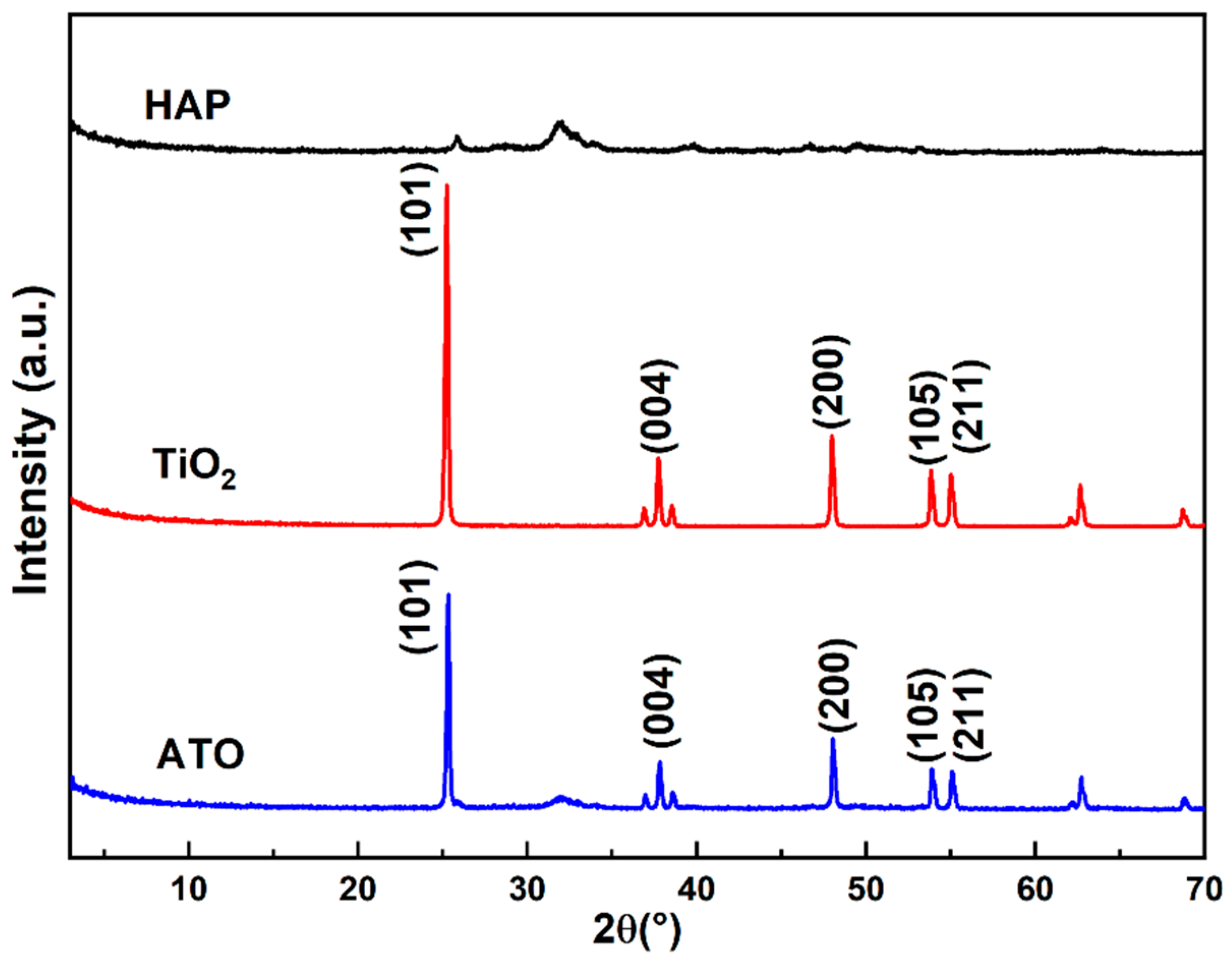
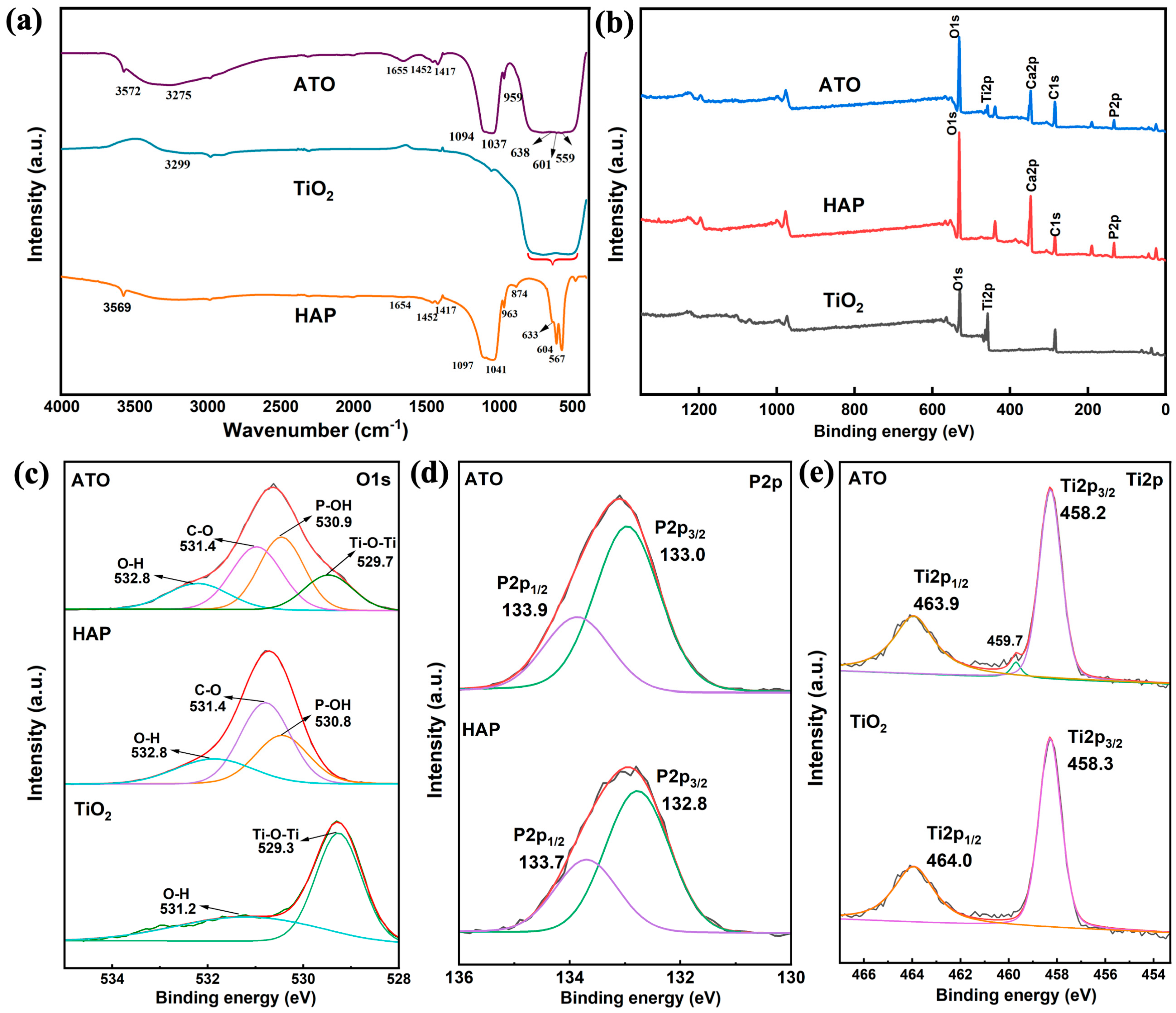


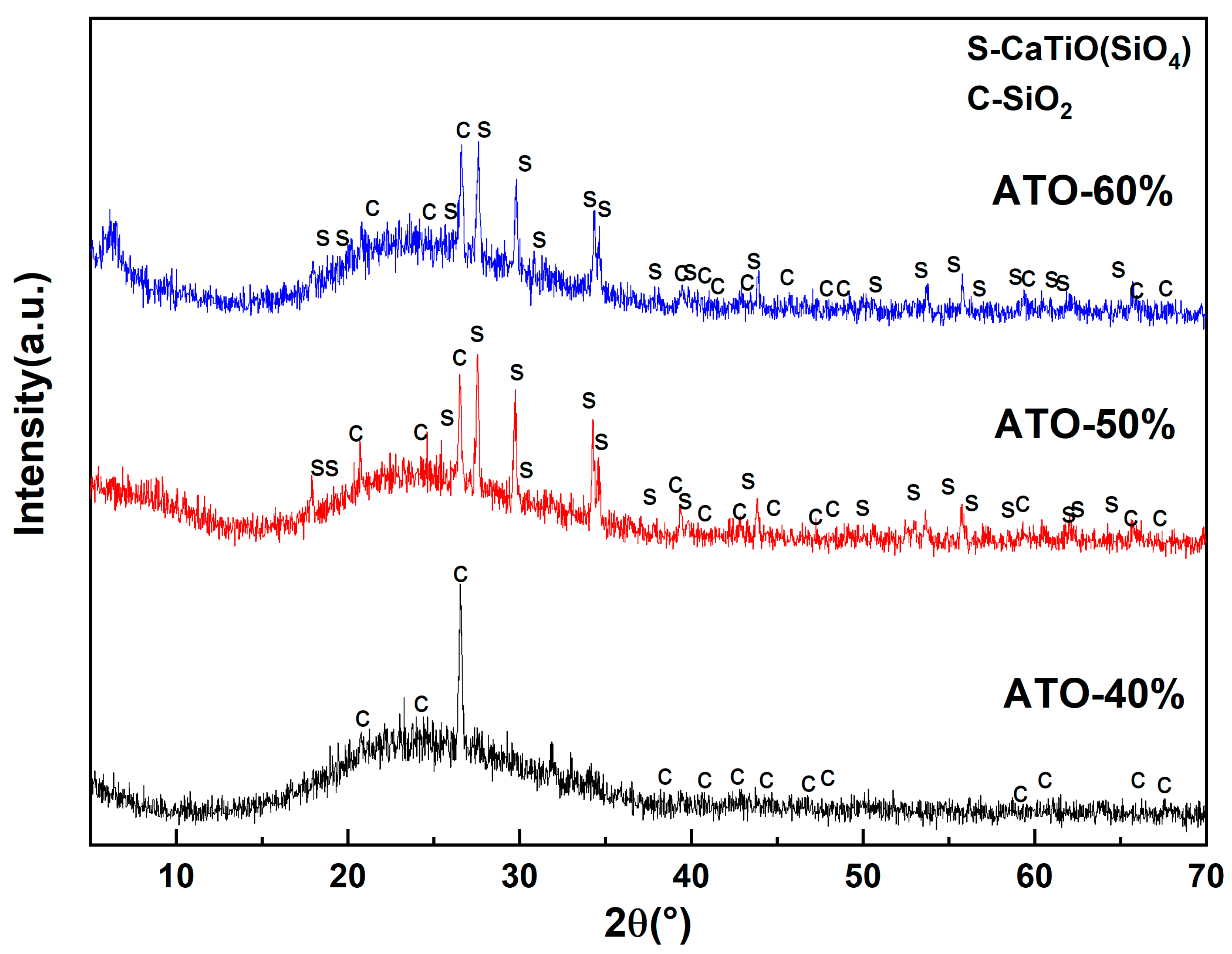
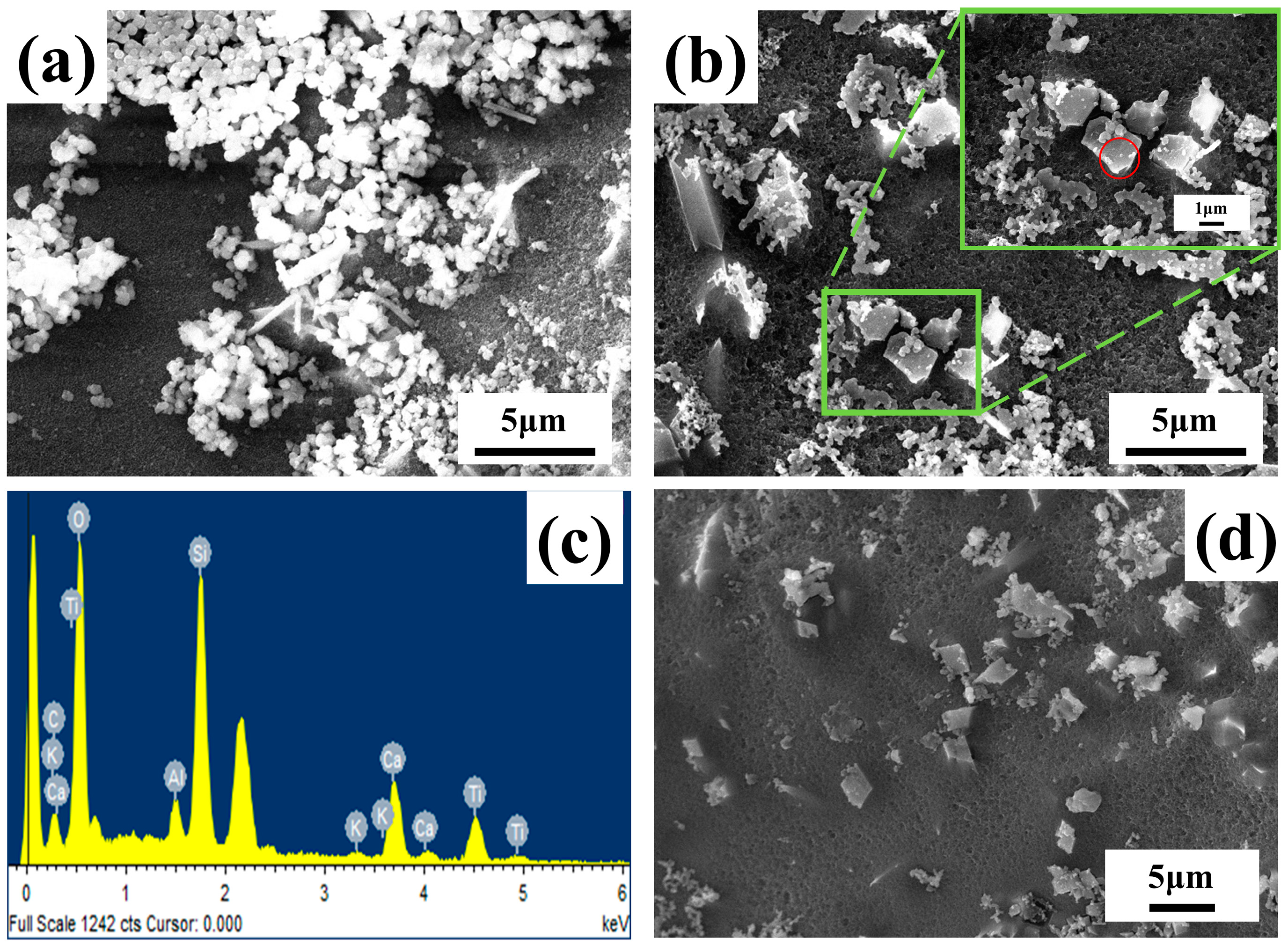
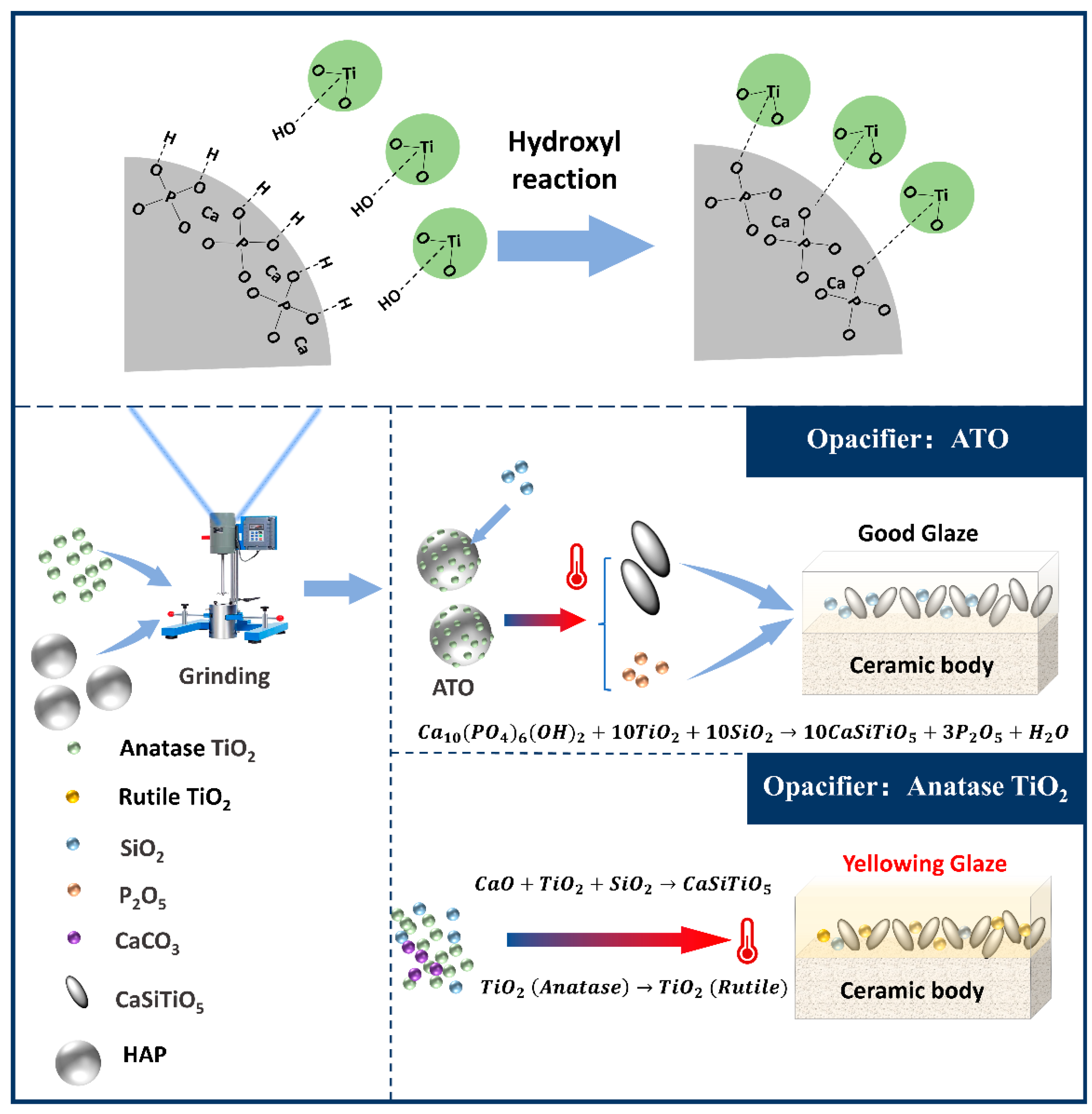
| Types of Apatite | CaO | P2O5 | SiO2 | Fe2O3 | MgO | Al2O3 | Others |
|---|---|---|---|---|---|---|---|
| HAP | 61.82 | 36.90 | 0.19 | 0.08 | 0.54 | 0.16 | 0.31 |
| CAP | 58.25 | 27.87 | 3.29 | 2.98 | 2.00 | 0.39 | 5.22 |
| Vibration Type | Wavenumber (nm−1) | ||
|---|---|---|---|
| HAP | TiO2 | ATO | |
| Ti-O-Ti [14] | — | 500–800 | 500–800 |
| PO43− (γ4) [24] | 567, 607 | — | 559, 601 |
| CO32- [25] | 874, 1417, 1452 | — | 874, 1417, 1452 |
| PO43− (γ1) [26] | 963 | — | 959 |
| PO43− (γ3) [27] | 1041, 1097 | — | 1037, 1094 |
| H-O-H (HAP) [28] | 1655 | — | 1654 |
| Ti-OH (TiO2) [13] | — | 3299 | 3275 |
| P-OH (HAP) [29] | 3569 | — | 3572 |
| Opacifiers | L* | a* | b* | Melting Length (cm) | Gloss (GU) |
|---|---|---|---|---|---|
| ATO-40 | 74.10 | 0.76 | 1.76 | 4.82 | 92.3 |
| ATO-50 | 89.99 | −0.85 | 3.37 | 4.79 | 89.0 |
| ATO-60 | 84.41 | −0.40 | 3.85 | 4.69 | 90.5 |
| Opacifies | L* | a* | b* | Color | Glaze Characteristics |
|---|---|---|---|---|---|
| ATO | 89.99 | −0.85 | 3.37 | White | Smooth, delicate, bright |
| PTO | 88.10 | −1.07 | 3.10 | White | |
| ZrSiO4 | 88.24 | −0.02 | 2.29 | White | |
| TiO2 | 92.13 | −1.16 | 9.18 | Yellow |
| Elements | Ti | Si | Ca | O | Al | K | Totals |
|---|---|---|---|---|---|---|---|
| Mass percentage (%) | 23.30 | 13.73 | 20.63 | 39.80 | 1.52 | 1.03 | 100.00 |
| Atomic percentage (%) | 11.98 | 12.04 | 12.68 | 61.27 | 1.38 | 0.65 | 100.00 |
Disclaimer/Publisher’s Note: The statements, opinions and data contained in all publications are solely those of the individual author(s) and contributor(s) and not of MDPI and/or the editor(s). MDPI and/or the editor(s) disclaim responsibility for any injury to people or property resulting from any ideas, methods, instructions or products referred to in the content. |
© 2024 by the authors. Licensee MDPI, Basel, Switzerland. This article is an open access article distributed under the terms and conditions of the Creative Commons Attribution (CC BY) license (https://creativecommons.org/licenses/by/4.0/).
Share and Cite
Bai, X.; Zhang, H.; Tu, Y.; Sun, S.; Li, Y.; Ding, H.; Bai, M.; Chang, L.; Zhang, J. Preparation and Application of Apatite–TiO2 Composite Opacifier: Preventing Titanium Glaze Yellowing through Pre-Combination. Materials 2024, 17, 1056. https://doi.org/10.3390/ma17051056
Bai X, Zhang H, Tu Y, Sun S, Li Y, Ding H, Bai M, Chang L, Zhang J. Preparation and Application of Apatite–TiO2 Composite Opacifier: Preventing Titanium Glaze Yellowing through Pre-Combination. Materials. 2024; 17(5):1056. https://doi.org/10.3390/ma17051056
Chicago/Turabian StyleBai, Xuefeng, Han Zhang, Yu Tu, Sijia Sun, Yangzi Li, Hao Ding, Ming Bai, Liang Chang, and Jianmeng Zhang. 2024. "Preparation and Application of Apatite–TiO2 Composite Opacifier: Preventing Titanium Glaze Yellowing through Pre-Combination" Materials 17, no. 5: 1056. https://doi.org/10.3390/ma17051056
APA StyleBai, X., Zhang, H., Tu, Y., Sun, S., Li, Y., Ding, H., Bai, M., Chang, L., & Zhang, J. (2024). Preparation and Application of Apatite–TiO2 Composite Opacifier: Preventing Titanium Glaze Yellowing through Pre-Combination. Materials, 17(5), 1056. https://doi.org/10.3390/ma17051056






